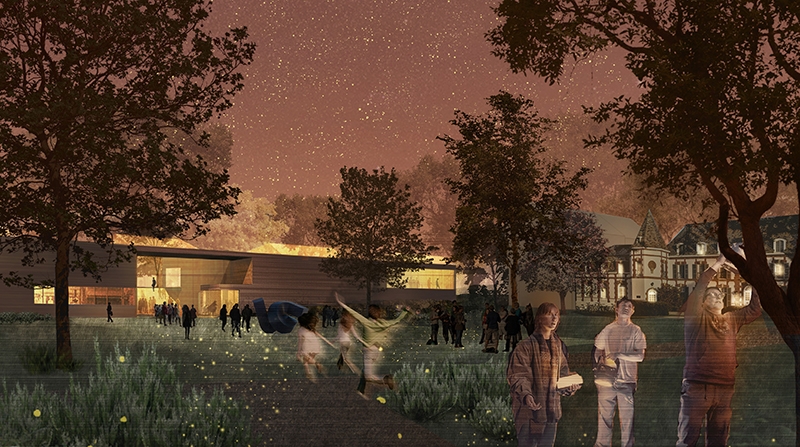Trustees Select Architect to Design New Art Museum

The Middlebury Board of Trustees has selected Allied Works, an architectural firm based in Portland, Oregon, and Brooklyn, New York, to design a new art museum. The building will be located near the current site of Battell Hall, as part of the reconfiguration and enhancement of the north side of campus.
“The museum project is part of the College’s broader mission to deepen the role of the arts in our academic and residential settings, particularly in their role as effective vehicles for participation in public life,” said Middlebury President Laurie Patton. “We have learned from our students that the arts inspire involvement in communities and support democratic engagement.”
The new museum will be designed to promote the arts and democracy and reinforce the power of the arts to communicate and promote the common good, according to Patton. It will expand access to Middlebury’s extensive art collection and create a dynamic public space on campus for interdisciplinary engagement and community gathering.
“A teaching museum’s mission has always been to awaken students, faculty, staff, and the community to the richness and diversity of the human experience at any given time or location,” Patton said. “In building the new museum, we will go even deeper, and show how the arts can encourage public discussion and change people’s hearts and minds. The arts enable all who engage with them to imagine new worlds and new ways of being together in a democratic society.”
An ‘Arts Agora’
The museum will be adjacent to the Johnson Memorial Building, Wright Memorial Theatre, Sunderland Language Center, and le Château. “Together, these buildings will form an ‘arts agora’—a dynamic space for assembly, creativity, and shared engagement,” Patton said. “This new arts hub will offer students, faculty, staff, and community members opportunities to let their creativity shape the public square.”
Allied Works, an integrated architecture and design practice established in 1994 and operating from studios in Brooklyn, New York, and Portland, Oregon, is known for its collaborative approach to museum design. The firm’s portfolio includes museums and cultural projects, educational facilities, residences, and workplaces—all of varied scale, purpose, and character—in locations across the globe.
Principal and founder Brad Cloepfil and principal Chelsea Grassinger will lead the project team. They have worked on many of the firm’s major academic, civic, and museum projects including the Palmer Museum of Art at Penn State, the National Veterans Memorial and Museum, the Clyfford Still Museum, and the National Music Centre Canada. McLeod Architects will serve as the Middlebury representative to the design and planning process. Principal John McLeod is an associate professor of architecture at the College, and his firm designed the recent renovation of the Johnson Memorial Building.
“Our goal is to create a place of wonder, where the architecture amplifies the place it occupies and the work it holds and inspires—a place of imagination and exploration for Middlebury and the world,” Cloepfil said.
Battell Hall will be replaced by a new first-year residence hall, scheduled to open in summer 2025, creating an ideal location for the new museum. Battell will remain in use through summer 2026 to allow for a major renovation of another first-year residence, Stewart Hall. Design, permitting, and selection of a construction management team for the new museum will begin in 2025. Construction is expected to start in 2027 and be completed in 2028.
More Space for Teaching, Exhibitions
The museum will be funded by gifts from donors who believe in the central role of a teaching museum in a liberal arts education. To date, nearly $35 million has been raised toward the estimated $50 million cost for design and construction. An additional $5 million will be sought in support of an endowment to pay for operations in years to come.
The new museum will expand exhibition and teaching spaces by nearly double and make the College’s collection of approximately 7,000 works significantly more accessible. Alongside exhibit and teaching spaces, it will feature flexible areas that support teaching and learning across disciplines.
A special feature will be dedicated spaces for object study, allowing students to closely engage with art and artifacts from our collections. This hands-on experience deepens understanding by connecting directly with the creative process and historical context—whether examining an ancient Greek vase or a contemporary sculpture.
In keeping with Middlebury’s commitment to sustainability, the museum will reflect the highest environmental standards, integrating sustainable materials, energy-efficient practices, and thoughtful connections with the surrounding landscape.
“The arts have always been essential to democratic life, allowing us to envision new worlds and connect across differences,” Patton said. “Our student-run arts festival, Nocturne, shows how transformative this can be. The new museum and arts quadrangle will bring that spirit into the heart of our campus, creating a lively artistic hub with spaces for outdoor exhibits, music, sculpture, and performance.”

